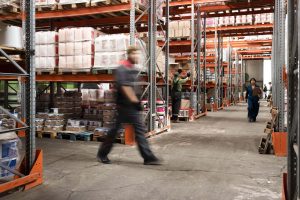Many myths surround warehouse automation, from its unaffordability to the time, cost, and effort involved in ripping floors or demolishing racks. But imagine if you could retrofit robotics into your existing racking structure. It sounds like a dream. Well, it’s not!
Modern warehouse automation systems can seamlessly integrate into your infrastructure without physical alterations. Read on to learn how retrofitted warehouse automation can transform fulfillment, enabling you to move products in your warehouse with the same agility as you move data.
The Myths Around Automated Warehouses
Legacy warehouses are unable to keep up with today’s rapid and dynamism. This is why most companies are looking forward to embracing warehouse automation systems. However, the time, effort, and cost involved in constructing an automated warehouse from scratch act as a deterrent for many.
Several myths surround these automated warehouse robots, from long and complicated installations to expensive infrastructures that are time-consuming to create. These myths prevent businesses from using the latest innovations and, thus, affect pick accuracy and time.
Let us take a look at the most common myths of warehouse automation:
- Warehouse automation systems demand excessive floor preparation: In setting up an automated warehouse, many companies picture a lot of floor preparation, which can be costly and time-consuming. Structural adjustments, expansion of aisles, and a complete overhaul of the storage system are top concerns.
- Building an automated warehouse is costly and time-consuming: Setting up an automated warehouse is considered a complex and effortful endeavor. Companies delay making decisions about this advanced technology because it may take months, if not years, before the warehouse is fully operational.
- Automated warehouse robots require ripping and replacing racks: Most organizations similarly perceive that automation, including robots, will require a complete warehouse restructuring. This would extensively involve replacing existing shelving and storage systems, which would be costly and disruptive to existing operations.
The Truth About Modern Warehouse Automation Systems
Automating warehouses does not always have to be a greenfield project. Old warehouses can be refurbished instead of building a new one, allowing businesses to reap the rewards of modern warehouse automation. Modern warehouse automation solutions are modular, allowing enterprises to scale automation one aisle at a time.
Businesses can retrofit these automated systems into rack-supported mezzanines, low ceilings, and high bay racks without any floor preparation or permit. As business needs grow, they can scale warehouse automation across the larger enterprise.
That said, here’s what modern warehouse automation systems bring to the table:
- Digital twin validations: Every modern warehouse automation system can be validated using patented digital twin technology. Businesses can visualize, simulate, and test virtual representations of automated warehouse robots before implementation to optimize workflows and correct possible inefficiencies.
- Ergonomic pick walls: Ergonomic pick walls present multiple totes, enhancing throughput and improving order fulfillment efficiency and accuracy. Automated warehouse robots can easily pick items in batches, decreasing labor use while increasing productivity.
- Gamified operator consoles: Warehouse automation doesn’t have to be boring and mundane. Contemporary solutions incorporate gamified operator consoles, transforming the monotonous picking procedure into a more enjoyable atmosphere for operators. This, in turn, maximizes their productivity and reduces error incidences.
- Standard totes and racks: Modern warehouse automation solutions use standard totes and racks, minimizing install time and operational disruptions. Scalable components can simplify processes, transform automated fulfillment, and enhance customer satisfaction.
- Scalable bot paths: Automated warehouse robots can be easily implemented by leveraging bot paths, lifts, and bots designed to scale with business growth. Easily configurable software stacks ensure businesses can manage and meet demand fluctuations effectively.
- Seamless integration: Modern warehouse automation systems have a cloud-native orchestration layer that integrates smoothly with existing WMS/WES systems. Businesses can also leverage a multi-tenant architecture that accommodates workflows for different business needs and customer requirements.
- Intelligent learning algorithms: Today, automated warehouses utilize intelligent learning algorithms to optimize SKU placement in real time for fast tote presentation. These storage/retrieval and pathfinding algorithms can present over 500 totes per hour.
Building the Automated Warehouse of the Future with Carte+
Establishing an automated warehouse can seem daunting, but modern solutions can make the transition to warehouse automation smooth and stress-free. Modern warehouse automation systems can be easily retrofitted into existing warehouses, allowing the workforce to adapt quickly and ensure optimized operations. Instead of conducting a complete overhaul of the warehouse, businesses can take a phased approach to warehouse automation and scale operations as they see fit. This modular approach increases the chances of success while making it less frightening for businesses of all sizes.
Cartesian Kinetics’ proprietary warehouse automation system, Carte+, is a modern solution that is easy to install and manage. It can retrofit into existing warehouse racks and mezzanines and requires no physical or structural changes to flooring or walls. Integrating quickly with minimal disruption, it eliminates the need to rip and replace shelves, enabling installations in less than six weeks.
Reimagine your warehouse operations, one Automated Aisle at a time, with Carte+!





